INFRARED PHOTOGRAPHY
The human eye only can only see electromagnetic wavelengths between .35 and .7 microns, but today’s technology lets us see well outside of this regime. Infrared (IR) is the part of the electromagnetic spectrum that is above .7 microns (700 nanometers) in wavelength. Film that is sensitive to the infrared part of the spectrum was developed in the 1930?s by adding various dyes to the silver halide crystals.
Since infrared is a longer wavelength than visible light, it can have a different penetration capability with various materials. Some materials that are opaque to visible light, such as paints and oils, become transparent under IR light. By using IR sensitive film, a photograph of a painting can look completely different because of different opacities of the materials in the visible and IR spectrum. In this way, IR photography can be used to look underneath a painting to observe what lies below the paint in a non-destructive manner.
These images show the true color reflectogram of this painting and the near infrared reflectogram (1000-1200 nm). The images were acquired using the Artist multi-spectral imaging system.
For IR photography, the subject needs to be illuminated by a light source that radiates well into the IR spectrum. Different filters can be used with the camera to block some or all of the visible light to alter the resultant image. IR photography works really well for observing very IR reflective materials such as graphite and coal. This makes IR especially good for observing underdrawings that are routinely done by artists on the canvas prior to painting their work. This is one of the most valuable reasons for using IR photography in forensic research.
Because of the wavelengths that are used, however, IR photography is not able to penetrate blue pigments and some green hues. Therefore, IR photography tends to only produce good results with paintings that are predominately in white, brown, and red hues, while the areas of the painting that are green and blue will simply look black in an IR photograph.
 |
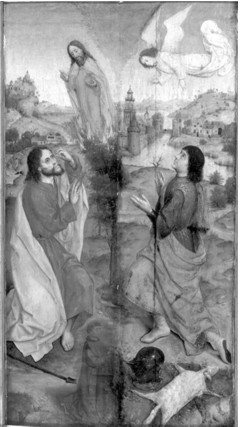 |
||
Moses and the burning bush and Gideon and the fleece, Albrecht Bouts, ca.1460-1549 |
These images show the true color reflectogram of this painting and the near infrared reflectogram (1000-1200 nm). The images were acquired using the Artist multi-spectral imaging system. |
||
In the early days of using IR photography, pictures were taken with an infrared sensitive film; the film was typically sensitive to wavelengths up to 1.7 microns. Using the infrared spectrum for analysis came into its own, however, in the 1960?s with the development of Infrared Reflectography (IRR) developed by Dutch physicist J. R. J. van Asperen De Boer. The process of IRR photography involves illuminating a picture using an infrared lamp, similarly to traditional photography. However, instead of a film as the sensitive medium, an IR detector is used. In this way, IRR can be sensitive to wavelengths up to 14 microns. This is especially important since it has been found that underdrawings of graphite or charcoal are most sensitive to IR wavelengths of two to three microns.
These images show the true color reflectogram of this painting and the near infrared reflectogram (1000-1200 nm). The images were acquired using the Artist multi-spectral imaging system.
For IR photography, the subject needs to be illuminated by a light source that radiates well into the IR spectrum. Different filters can be used with the camera to block some or all of the visible light to alter the resultant image. IR photography works really well for observing very IR reflective materials such as graphite and coal. This makes IR especially good for observing underdrawings that are routinely done by artists on the canvas prior to painting their work. This is one of the most valuable reasons for using IR photography in forensic research.
Because of the wavelengths that are used, however, IR photography is not able to penetrate blue pigments and some green hues. Therefore, IR photography tends to only produce good results with paintings that are predominately in white, brown, and red hues, while the areas of the painting that are green and blue will simply look black in an IR photograph.
In the early days of using IR photography, pictures were taken with an infrared sensitive film; the film was typically sensitive to wavelengths up to 1.7 microns. Using the infrared spectrum for analysis came into its own, however, in the 1960?s with the development of Infrared Reflectography (IRR) developed by Dutch physicist J. R. J. van Asperen De Boer. The process of IRR photography involves illuminating a picture using an infrared lamp, similarly to traditional photography. However, instead of a film as the sensitive medium, an IR detector is used. In this way, IRR can be sensitive to wavelengths up to 14 microns. This is especially important since it has been found that underdrawings of graphite or charcoal are most sensitive to IR wavelengths of two to three microns.
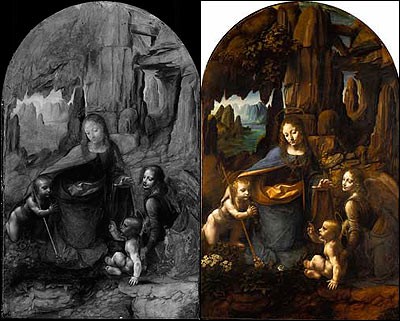 |
||
The Virgin of the Rocks, Leonardo DaVinci. The IRR image showed two different underdrawings beneath the actual painting. |
The original IRR technique used a vidicon system which is essentially a television set attached to an IR sensitive tube. The image on the television was then photographed for a permanent copy of the image. Since television has such poor resolution, only small parts of each painting could be imaged at one time and a resulting mosaic of the images is generated. Creating this mosaic tended to introduce errors in tone and contrast due to different lighting and angles.
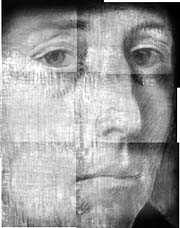 |
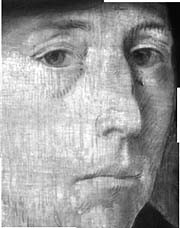 |
||
image done with vidicon system |
and same image using the analog signal from the camera and digitizing it. |
In the 1990’s, CCD imaging systems sensitive to the IR spectrum were developed, and these quickly became the detector of choice. The resolution was still poor, however, and so these detectors have been typically used in a scanning format, similar to the way your television picture is drawn by a scanning electron tube.
The advantages of the scanning IR reflectography systems over IR photography are tremendous. With CCD systems, the image from the system are digital and immediately available. You no longer have to wait the half hour or so a film development would take. Since the resultant image is digital, newer imaging processing techniques can also be used with the data produced by IRR systems.
Like IR photography, you still cannot penetrate blue pigments with IRR; green hues, however, are transparent which increases the usefulness of IRR systems. Unfortunately, underdrawings done with media such as red chalk will not appear in an IRR image. Also, any portions of a painting that are done with an IR opaque medium will not yield any information. Additionally, it can be difficult to generate enough contrast in the IR images without significant digital image processing which can then introduce more artifacts and errors.
There are commercial IRR systems that are available and typically are cheaper than IR photography systems. One such IRR system is available from Art Innovation.
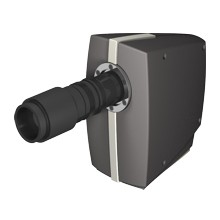
The ARTIST is a multi-spectral imager that can provide UV, visible, and IR images of the work simultaneously. Having commercially available equipment like this means that any medium sized forensic laboratory would be able to afford an IRR system.
The future of IRR technology is multi-spectral IRR. With multi-spectral IRR, multiple detectors that are sensitive to only small parts of the IR spectrum are used simultaneously. In this way, you will get multiple images, each from different portions of the IR spectrum and all at the same time. This can be extremely informative as different materials will be transparent or opaque at different parts of the IR spectrum. By using multi IRR, you can get a much clearer idea of the materials and pigments used under the paint itself.
In the final analysis, infrared reflectography can be a useful forensic tool for a variety of different projects. And, with the advent of imaging systems that combine IR with visible light images, IRR is becoming a more cost effective analysis method as well.
